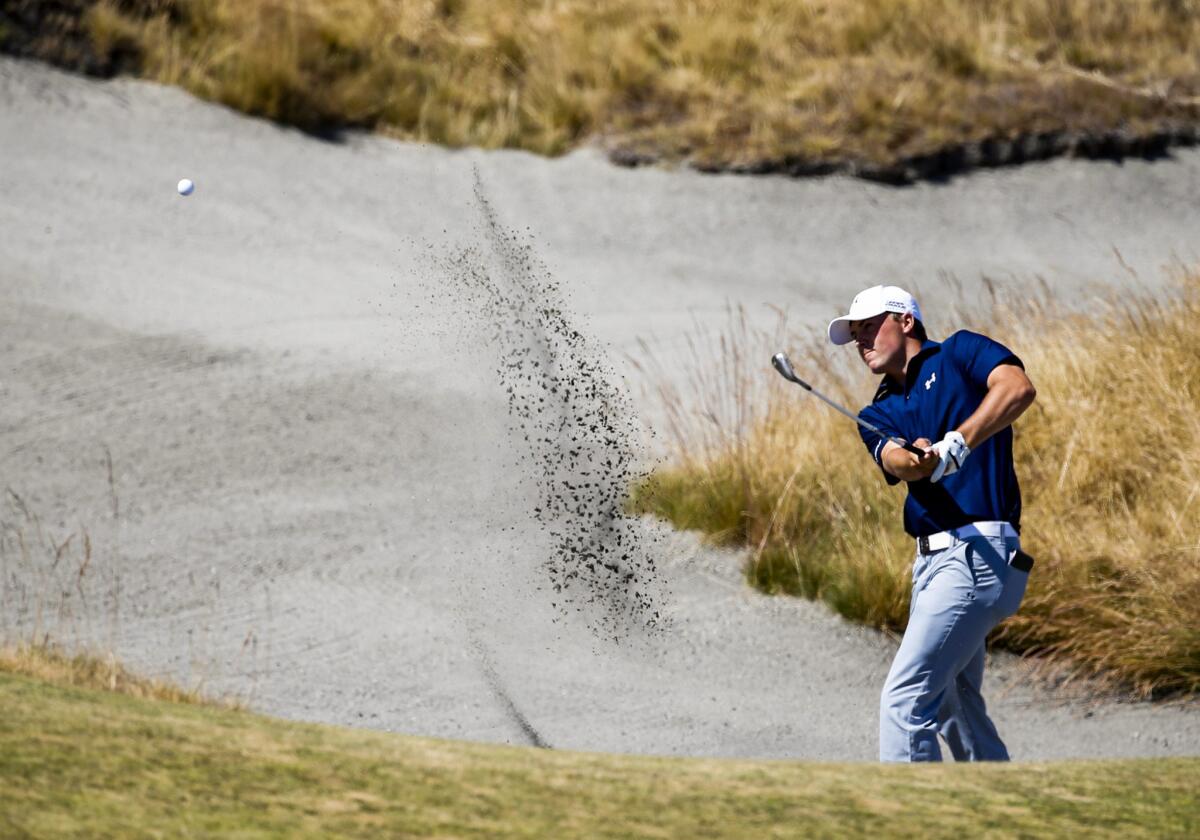Jordan Spieth has a problem with the 18th hole

Jordan Spieth hits out of a sand trap on the eighteenth hole during the second round of the U.S. Open on Friday at Chambers Bay in University Place, Wash.
- Share via
UNIVERSITY PLACE, Wash. — In about the time it takes for a yellow light to turn red, Jordan Spieth went from heaven to hell.
That’s golf — especially U.S. Open golf.
Spieth knocked home an 11-foot birdie putt on No. 17, his eighth hole of the second round Friday, to take the outright lead at six under par. The sun was shining at Chambers Bay. Puget Sound, just to the right of the 17th green, provided a cool breeze. Spieth grinned and nodded at the adoring spectators in the grandstand.
And then …
&$%@%#&*!
Spieth hooked his tee shot into a fairway bunker on the 18th, which played Friday as a narrow, 514-yard par-four. He barely cleared the lip with second shot. Next came his loose lips.
“This is the dumbest hole I’ve ever seen in my life,” he barked to caddie Michael Greller.
After his round, the ever-prepared Spieth was ready for the question regarding his outburst. To his credit, he did not back down.
“I think 18 as a par-four doesn’t make much sense,” he said. “Of course at the moment when I didn’t hit the right shots, it’s going to make less sense. And whatever, if microphones are going to pick up [what I say], they’re going to pick it up. I’m not going to put a smile on and be happy with the way I played the hole. I am who I am.”
The schizophrenic 18th played as a par-five Thursday and will do so again Saturday. As a par-four, players either have to fly the fairway bunkers on the left or stay short of a cross-bunker on the right that’s 325 yards from the tee. The hole was downwind Saturday, bringing the cross-bunker well into play.
“I just didn’t know where I could hit that tee shot,” Spieth said. “And I wasn’t going to hit a three-iron off the tee and then hit three-wood [for his second shot]. So all in all, I thought it was a dumb hole today. But I think we’re going to play it from there again, so I have to get over that.”
Perfect reaction: Make your point. Then move on.
Spieth, off a downhill lie from wispy fescue, dumped his third shot into a bunker short of the green, leading to a double-bogey six. But he immediately got one back with a birdie on the par-five first.
His drive found the left rough on No. 1, and steam was coming from his ears as he walked to his ball with Greller.
“I was really frustrated,” he recalled, “and Michael did a great job of telling me: ‘Don’t let this get to you. You’re still very much in this tournament.’ If the second something gets to you, you’re in trouble in a U.S. Open.”
Spieth gets it. He’s only 21 and already has a complete understanding of how to win majors. A U.S. Open victory — he’s tied for the lead with Patrick Reed — would be two straight after his Masters runaway.
His driver/six-iron/wedge combo on No. 1 left him with 13 feet. He drained it to move to five under. Just like that, his self-described “bad decision” to hit nine-iron instead of sand wedge out of the fairway bunker on 18 had been minimized. He made one birdie and one bogey over his final eight holes.
He had given up two runs in the top of the inning but responded with a solo bomb in the bottom half. He was still alive and well.
“The front nine, I believe, is the harder of the two nines,” he said. “I told Michael when we were walking down [No. 1], let’s try to get one birdie on this nine [because] there are not many chances. Accept that three under is about the lowest score that was possible.”
He shot three under.
He is Jordan Spieth.
More to Read
Go beyond the scoreboard
Get the latest on L.A.'s teams in the daily Sports Report newsletter.
You may occasionally receive promotional content from the Los Angeles Times.











